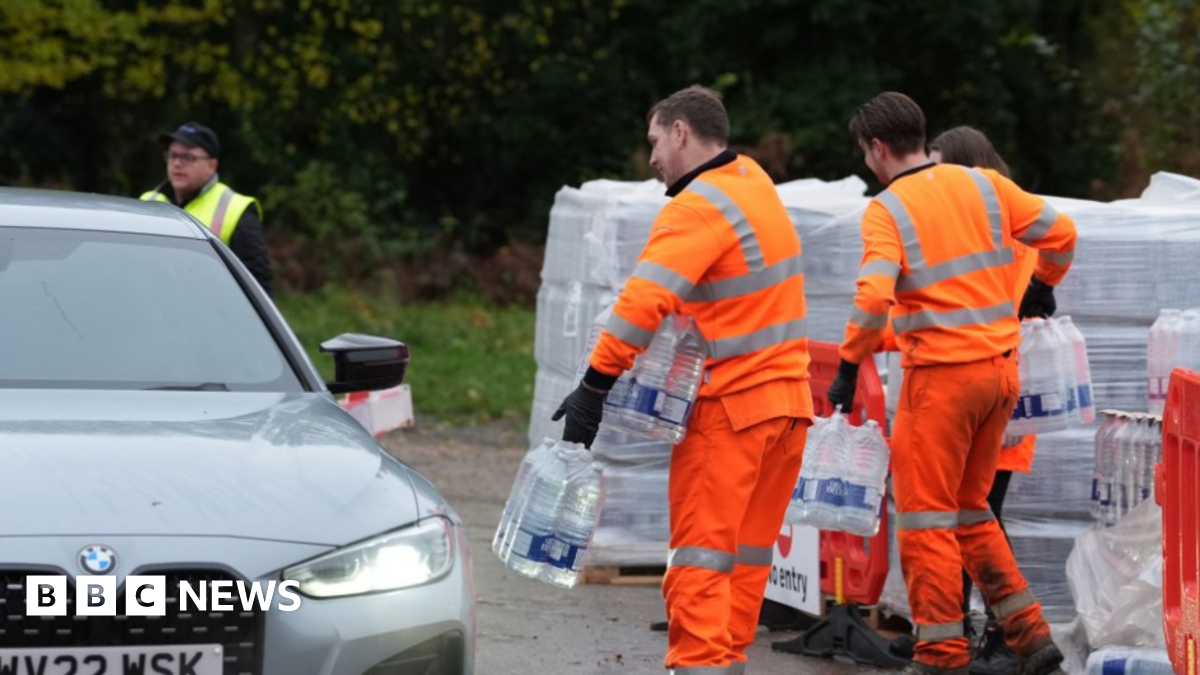Vulnerable communities still struggling with aging water systems – AFRO American Newspapers

Report on the U.S. Water Access Crisis and its Implications for Sustainable Development Goals
A significant portion of the U.S. population, particularly within vulnerable communities, faces a severe water crisis that directly contravenes several United Nations Sustainable Development Goals (SDGs). This report analyzes the challenges of pollution, aging infrastructure, and systemic underinvestment, highlighting the disproportionate impact on minority communities and the urgent need for action to meet global sustainability targets.
SDG 6: The Core Challenge of Clean Water and Sanitation
The fundamental right to clean water and sanitation, as outlined in SDG 6, is not universally met in the United States. The crisis is marked by a failure to ensure available and sustainable management of water and sanitation for all.
- Approximately 2.2 million Americans reside in homes lacking running water or basic plumbing facilities.
- This gap in access undermines the core tenets of SDG 6, which aims for universal and equitable access to safe and affordable drinking water.
- Alice Volpitta of Blue Water Baltimore emphasizes that despite the 1972 Clean Water Act, the promise of “fishable, swimmable, drinkable waterways” remains unfulfilled, with chronic sewage contamination plaguing water bodies.
SDG 10: Addressing Systemic Inequalities in Water Access
The water crisis disproportionately affects minority populations, highlighting a critical failure in achieving SDG 10 (Reduced Inequalities). The data reveals significant racial disparities in access to basic services.
- According to research by DigDeep, Black and Latino households are twice as likely as White households to live without access to basic plumbing.
- In Baltimore, analysis shows that neighborhoods with a higher percentage of Black residents are statistically more likely to experience sewage backups, a clear example of environmental injustice that SDG 10 seeks to eliminate.
Case Studies: Infrastructure Failures and Community Impact
Specific urban crises in Baltimore and Flint, Michigan, serve as stark illustrations of the consequences of failing infrastructure and governance, impacting community health and sustainability.
Baltimore: Infrastructure Decay and Environmental Justice
Baltimore’s aging infrastructure leads to severe environmental and public health issues, challenging the objectives of SDG 11 (Sustainable Cities and Communities) and SDG 6.
- Waterways such as Jones Falls and Herring Run have experienced massive overflows of storm and sewer water, with one incident in 2019 releasing approximately 45 million gallons.
- Failing underground systems result in sewage backups in homes, creating unsanitary living conditions that are antithetical to the goals of sustainable urban living.
Flint, Michigan: A Public Health and Governance Crisis
The Flint water crisis is a prominent example of how policy decisions can lead to catastrophic public health outcomes, directly impacting SDG 3 (Good Health and Well-being) and SDG 16 (Peace, Justice and Strong Institutions).
- The 2014 decision to switch the city’s water source to the Flint River without proper anti-corrosion treatment exposed nearly 100,000 residents to lead contamination.
- This exposure has caused long-term health problems, particularly in children, and led to an outbreak of Legionnaires’ disease, undermining public trust in institutions.
- Despite a pipe replacement program, activists report that lead pipes remain and residents continue to rely on bottled water, indicating that a complete resolution in line with SDG 3 and SDG 6 has not been achieved.
Economic and Social Implications
The failure to provide universal water access has significant economic and health repercussions, hindering progress toward national prosperity and well-being.
SDG 8: The Economic Cost of Inaction
The water access gap imposes a substantial economic burden, conflicting with the principles of SDG 8 (Decent Work and Economic Growth).
- The U.S. economy loses an estimated $8.58 billion annually due to factors like reduced earnings, healthcare costs, and labor disruptions linked to inadequate water access.
- Conversely, closing this gap could generate an estimated $200 billion in economic value over the next 50 years, promoting sustainable economic growth.
Policy, Activism, and the Path Forward
Addressing the water crisis requires robust policy, sustained funding, and community-led initiatives. However, recent policy rollbacks threaten to reverse progress made in environmental justice and equity.
Challenges in Policy and Funding
Dr. Tiara Moore of Black In Marine Science noted that federal rollbacks of diversity, equity, and environmental initiatives are halting or reversing progress achieved since 2020. This creates a significant obstacle to securing the institutional support needed to advance the SDGs. To overcome these challenges and prevent the financial burden of infrastructure repair from falling on residents, state-level support and community collaboration are essential.
Analysis of Sustainable Development Goals in the Article
1. Which SDGs are addressed or connected to the issues highlighted in the article?
- SDG 3: Good Health and Well-being: The article discusses the severe health consequences of contaminated water, such as lead exposure and Legionnaires’ disease, which directly impact public health and well-being.
- SDG 6: Clean Water and Sanitation: This is the central theme of the article, which details the lack of access to safe drinking water, basic plumbing, and sanitation services, as well as the pollution of waterways due to sewage overflows.
- SDG 8: Decent Work and Economic Growth: The article quantifies the economic impact of the water access gap, including annual losses in earnings and tax revenues, and the potential economic value that could be unlocked by addressing the issue.
- SDG 10: Reduced Inequalities: The article explicitly highlights racial disparities, stating that Black and Latino households are disproportionately affected by the lack of basic plumbing and that Black residents in Baltimore are more likely to experience sewage backups.
- SDG 11: Sustainable Cities and Communities: The focus on urban water crises in cities like Baltimore and Flint, caused by aging infrastructure and underinvestment, relates to the goal of making cities safe, resilient, and sustainable.
2. What specific targets under those SDGs can be identified based on the article’s content?
- Target 6.1: Achieve universal and equitable access to safe and affordable drinking water for all.
The article directly addresses this target by stating that “Approximately 2.2 million Americans live in homes without running water” and by detailing the Flint water crisis, where the water supply was contaminated with lead, making it unsafe to drink. - Target 6.2: Achieve access to adequate and equitable sanitation and hygiene for all.
This target is relevant as the article points out that millions of Americans lack “basic plumbing” and that residents in Baltimore experience “sewage backups in their homes as a result of our failing underground infrastructure.” - Target 6.3: Improve water quality by reducing pollution.
The article highlights the failure to meet the standards of the Clean Water Act, mentioning that waterways in Baltimore “are chronically contaminated with sewage overflows.” It specifies that “around 45 million gallons of storm and sewer water overflowed into Jones Falls and Herring Run.” - Target 3.9: Substantially reduce the number of deaths and illnesses from hazardous chemicals and water pollution and contamination.
The health impacts described in Flint, where “nearly 100,000 residents… had been exposed to lead” and faced a “spike in Legionnaires’ disease, a severe form of pneumonia,” directly connect to this target. - Target 10.2: Empower and promote the social, economic and political inclusion of all, irrespective of race, ethnicity, or other status.
The article points to a failure in achieving this target by providing statistics on racial disparity: “Black and Latino households are twice as likely to live without basic plumbing as White households” and neighborhoods with more Black residents in Baltimore are “statistically significantly more likely to experience a sewage backup.” - Target 11.1: Ensure access for all to adequate, safe and affordable housing and basic services.
The lack of running water and basic plumbing for 2.2 million Americans is a failure to provide basic services essential for adequate housing, directly relating to this target. - Target 8.1: Sustain per capita economic growth.
The article connects water access to economic performance by stating that “The U.S. economy loses $8.58 billion annually” due to the water gap and that “Closing the gap could unlock $200 billion of economic value over the next 50 years.”
3. Are there any indicators mentioned or implied in the article that can be used to measure progress towards the identified targets?
- Indicator for Target 6.1: The number of people without access to running water (“Approximately 2.2 million Americans”). Progress can also be measured by the number of lead pipes replaced (“replacing about 11,000 lead pipes” in Flint).
- Indicator for Target 6.2: The number of households without basic plumbing. The article also provides a disaggregated indicator by race, noting that “Black and Latino households are twice as likely to live without basic plumbing as White households.” The frequency of “sewage backups” is another implied indicator of inadequate sanitation infrastructure.
- Indicator for Target 6.3: The volume of untreated sewage released into waterways. The article provides a specific data point: “around 45 million gallons of storm and sewer water overflowed” in Baltimore. The general state of waterways (“chronically contaminated”) is also an indicator.
- Indicator for Target 3.9: The number of people exposed to waterborne contaminants and diseases. The article mentions that “nearly 100,000 residents of Flint had been exposed to lead” and references a “spike in Legionnaires’ disease.”
- Indicator for Target 10.2: The statistical likelihood of experiencing water issues based on race. The article provides clear comparative indicators, such as Black and Latino households being “twice as likely” to lack plumbing and Black residents being “statistically significantly more likely” to experience sewage backups.
- Indicator for Target 8.1: The economic cost of the water access gap and the potential economic benefit of closing it. The article provides specific monetary values: “$8.58 billion annually” in losses and a potential “$200 billion of economic value.”
4. Summary Table of SDGs, Targets, and Indicators
| SDGs | Targets | Indicators |
|---|---|---|
| SDG 6: Clean Water and Sanitation | 6.1: Achieve universal and equitable access to safe and affordable drinking water for all. | Number of people without running water (2.2 million); Number of lead pipes replaced (11,000 in Flint). |
| 6.2: Achieve access to adequate and equitable sanitation and hygiene for all. | Number of households without basic plumbing; Frequency of sewage backups in homes. | |
| 6.3: Improve water quality by reducing pollution. | Volume of sewage overflows (45 million gallons in Baltimore); Number of chronically contaminated waterways. | |
| SDG 3: Good Health and Well-being | 3.9: Substantially reduce the number of deaths and illnesses from hazardous chemicals and water pollution. | Number of residents exposed to lead (100,000 in Flint); Incidence of waterborne illnesses (spike in Legionnaires’ disease). |
| SDG 10: Reduced Inequalities | 10.2: Empower and promote the social, economic and political inclusion of all, irrespective of race. | Racial disparity in access to basic plumbing (Black and Latino households twice as likely); Statistical likelihood of sewage backups in neighborhoods with a higher percentage of Black residents. |
| SDG 11: Sustainable Cities and Communities | 11.1: Ensure access for all to adequate, safe and affordable housing and basic services. | Number of homes without basic services like running water and plumbing. |
| SDG 8: Decent Work and Economic Growth | 8.1: Sustain per capita economic growth. | Annual economic loss due to water access gap ($8.58 billion); Potential economic value unlocked by closing the gap ($200 billion). |
Source: afro.com
What is Your Reaction?
 Like
0
Like
0
 Dislike
0
Dislike
0
 Love
0
Love
0
 Funny
0
Funny
0
 Angry
0
Angry
0
 Sad
0
Sad
0
 Wow
0
Wow
0
















































:focal(1500,1000)/https://media.globalcitizen.org/a6/9a/a69a4720-d8a1-4715-b596-18738d03c05c/rotary_polio_hero_image.jpg?#)







/countries/sri-lanka/photo-credit---dmc-sri-lanka.tmb-1200v.jpg?sfvrsn=dc298bcc_1#)


















